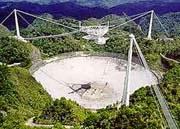 The Arecibo Observatory may have to find an alternative source of funds if it is to survive beyond 2011.NASA
The Arecibo Observatory may have to find an alternative source of funds if it is to survive beyond 2011.NASAWith the release of a long-awaited report, US astronomers now have a hit list of observatories that may have to shut down to save the National Science Foundation (NSF) money in coming years.
Among those hardest hit were the Arecibo radio telescope in Puerto Rico — famed for its role in the search for extraterrestrial intelligence — and the Very Long Baseline Array (VLBA), a group of ten telescopes scattered across the United States. Both programmes will have to obtain external funding by 2011 to avoid being shut down, the report suggests. It also advises closing the National Solar Observatory's facilities at Kitt Peak on the Tohono O'Odham Reservation in Arizona and Sacramento Peak in Sunspot, New Mexico.
The report comes from a committee tasked with shaving $30 million from the NSF ground-based astronomy budget — about 15% of the total budget for the NSF's Division of Astronomical Sciences. Over the next several months, the division will consider the recommendations, originally set to be released in April but not unveiled until last Friday.
Roger Blandford, director of the Kavli Institute for Particle Astrophysics and Cosmology at Stanford University, California, and chairman of the review committee, said that the cuts would be painful. "All of these telescopes are productive," he says. "All of them are good for another decade or so to do front-ranked science." His committee had to choose possible cuts based on several criteria, including operations cost, workforce training, estimates of scientific importance, and input from the astronomical community.
Future funding
The NSF budget for Arecibo is $12 million per year, $10 million of which comes from the Division of Astronomical Sciences. The committee is recommending that the division cut that funding to $8 million until 2011, at which time it would give up to $4 million to match money from outside contributors. If external funding is not raised, the telescope would close.
Mark Adams, a spokesman for the National Radio Astronomy Observatory, says that his institute has not yet been told how much money it must raise to keep the VLBA open. Nevertheless, he remains optimistic that additional contributors will step up from the international community of researchers who use the facilities. In particular, Adams points hopefully to the Japanese Institute of Space and Astronautical Science, which is planning to launch a space observatory programme in 2012 that would use ground-based telescopes such as the VLBA.
ADVERTISEMENT
Joseph Burns, vice-provost for physical sciences and engineering at Cornell University in Ithaca, New York, which manages Arecibo, says that belt-tightening could bring the telescope's budget down to the $8 million mark. But he thinks that getting more money from Arecibo's international users, as recommended by the review committee, is not likely. Although about 16% of Arecibo's users are foreign, Burns says that they are spread across the globe.
"To go to the Swiss and say, 'Give us a million dollars because you have two people who use the facilities' is not realistic," he says.
Visit our astronomersfacefacilityc.html">newsblog to read and post comments about this story.
